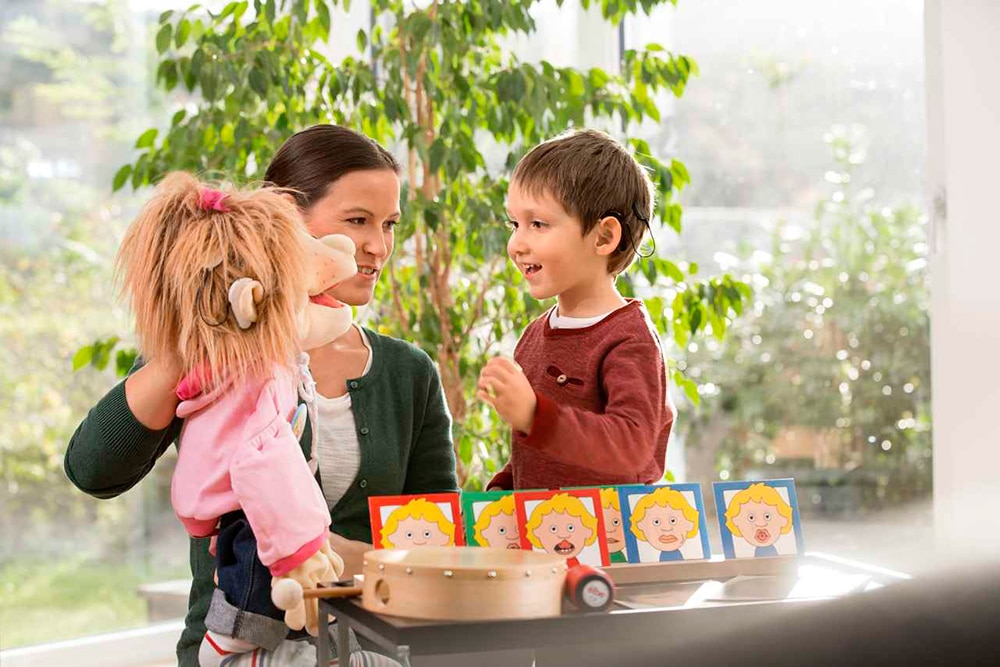
MED-EL
Published Jul 15, 2016 | Last Update Aug 20, 2024
16 Ways to Teach Past Tense Verbs to Your Child
Learning a language happens in stages. There are lots of different rules and exceptions, and this is especially true for learning past tense verbs: what happened in the past. Here’s some information about how children develop their past-tense language skills, and 16 different activities you can do to help them learn past tense verbs.

The Three Stages of Development
Children typically develop their verb tenses over many years early in their life. There are three main stages that they’ll go through:
- Beginning to speak a small number of frequently used verbs in the past tense.
Most of these verbs will be irregular, which means they don’t share a common format. Some common words are “ate,” the past tense of “eat;” “drank,” the past tense of “drink;” and “saw,” the past tense of “see.” - Beginning to add “-ed” to regular verbs, like turning “hop” into “hopped;” “like” into “liked,” and “try” into “tried.”
As children are developing their understanding of the regular past tense verb rule, they may add “–ed” to irregular verbs, and come up with non-existing words like “eated,” “swimmed,” or “runned.” - Correct use of regular and irregular verbs.
Different Verbs Sound Different
It can be tricky for a child to learn the past tense for regular verbs, because that same “-ed” ending can sound different depending on the verb being spoken. Here are some of the different ways:
- “-ed” sounds like “ed” or “id” (depending on your accent) in words like painted, waited, and landed.
This is the easiest form to hear, because it adds a completely new syllable to the end of the base verb. - “-ed” sounds like “d” in words like played, tried, and remembered.
Some of these are easy to hear and say because the ”d” sound stands out at the end of words that finish with a vowel sound, like “play” and “played.” - “-ed” sounds like “t” in words like walked, kissed, and liked.
These are the trickiest because the ending sounds soft and short. That means most children will need to hear it over and over to pick out the rule. And they’re more difficult to speak, because the ending doesn’t always easily flow from the base verb: “jumped” ends with an “mpt” sound . Because it is a blend of three consonant sounds, it can be difficult to learn how to say..
4 Activities for You
So, what’s the best way to help your child learn these complexities? Exposure, and repetition. Expose them to the right way of using a verb in the past tense by saying the word in meaningful situations so children can hear it being used correctly, and do it over and over and over.
Here are four games or activities that you can use to focus on the past tense.
Playing with toys
- With your child, pick out some dolls or action figures. Then, have them act out an action— something small like jump or run. Afterwards, tell your child what happened using the past tense: “Did you see the cat? It jumped.”
- Use a wind-up toy and let it move around on its own. Then, talk about what happened: “Wow, the robot walked across the floor.”
- Play hide-and-seek with the toys. Hide a stuffed animal somewhere, and then with your child go find it. Once you found it, say where: “I found She was under the couch.”
- Talk about your child’s favorite toys: “I thought your favorite was Fluffy the cat, but dad said yours was Coco the dog.” (And, talking about thoughts and feelings like this can also help your child to develop their Theory of Mind skills.)
Reading books
- Many children’s books are written in the past tense, so as you’re reading along just emphasize the past-tense verbs. For example, in The Very Hungry Caterpillar by Eric Carle, one of the sentences goes “On Monday he ate through one apple.”
- Look for books where there’s lots of movement, like Gallop! Waddle! Kick! By Rufus Butler Seder. As you’re reading take note of what is happening, and then repeat it in the past tense: “Hey, I saw that! The boy kicked a ball!”
- As you’re reading a story, make guesses about what will happen on the next pages. Then, after you’ve read them, talk about who was right: “I guessed it was a duck’s egg and you said you thought it was a chicken’s egg. We were both wrong. It turned out to be a dragon’s egg. Wow!” This again will double up to help develop your child’s Theory of Mind skills.
- Create your own experience book, and then talk about it in the past tense. You could include things like how you “went to grandma’s house,” “watered” her plants,” how your child “picked a flower,” and how they “gave” it to grandma.
Singing Songs and Rhymes
- When you’re saying a rhyme, put an emphasis on the past tense verbs, like: “The incy wincy spider climbed up the water spout, down came the rain and washed the spider out…”
- Make up a call-and-response song with lots of actions. For example, you could jump up and down and pat your head, and afterwards sing “I jumped up and down and I patted my head.” Then, have your child do the same thing. This will connect the action of jumping with the past-tense verb of jump.
- Listen to some songs with your child, and read through the lyrics. Then as you’re teaching your child some of the lines, highlight which of the words are in the past tense. Do this by talking about what they did in the song, and highlighting the verbs that you’re saying in the past tense.
- As you’re listening and a song finished, talk about it: “Wow, that was a great song. I haven’t heard it before.”
Doing Daily Routines
- As you’re doing daily routines like cooking, cleaning, or relaxing, talk with your child about what they’ve just done. For example, after dinner you could say “You did it! You finished your food. You ate it all up.”
- Talk about the feelings that you had earlier in the day: “I was tired before my nap,” or “The cat was hungry before we fed”
- Talk about the things you see, feel, smell, or hear: “I saw a balloon outside,” “I heard the cat meow,” “I smelled the food as it was cooking,” “I touched your new stuffed animal.”
- Talk about the things you feel: “Dad thought you were behind the curtains, but I knew you were under the bed because I saw your shoe.” Talking about thoughts and feelings like this while using past tense verbs will again double up to also develop your child’s Theory of Mind skills.
No matter which of these activities you do, keep this in mind: children learn and remember things better when they hear them at the end of the sentence. It can be hard to do this in English, because we tend to hide our verbs in the middle (even some of the examples here have done that), but try as much as you can to use verbs at the end of a sentence while your child is in the early stages of developing their use of verb tenses.
So, to do this you might want to rephrase some of the sentences you say in conversation. For example, you might say “Wow, that boy ran very fast! Did you see how fast he ran?” or “We washed your hands in the bathroom. Your hands are all washed!” Rephrasing like this is totally okay, because it lets you repeat the words and concepts naturally—helping your child to understand them best.
This post was written with help from Rebecca Claridge, a speech-language pathologist.
References
-
[1]
Hammer, A. (2010). The acquisition of verbal morphology in cochlear implanted and specific language impaired children. The Netherlands. LOT
-
[2]
Owen, A.J. (2010). Factors affecting accuracy of past tense production in children with specific language impairment and their typically-developing peers: The influence of verb transitivity, clause location and sentence type. Journal of Speech, Language and Hearing Research, 53, 993-1014
-
[3]
Owen Van Horne, A.J., & Fager, M.G. (2015). Quantifying the relative contributions of lexical and phonological factors to regular past tense accuracy. International Journal of Speech-Language Pathology, 17(6): 605-616
-
[4]
Rumelhart, D.E. & Mc Clelland, J.L.: Chapter 6: On learning the past tense of English verbs http://psych.stanford.edu/~jlm/papers/PDP/Volume%202/Chap18_PDP86.pdf (accessed 19/April/16)
References

MED-EL
Was this article helpful?
Thanks for your feedback.
Sign up for newsletter below for more.
Thanks for your feedback.
Please leave your message below.
Thanks for your message. We will reply as soon as possible.
Send us a message
Field is required
John Doe
Field is required
name@mail.com
Field is required
What do you think?
© MED-EL Medical Electronics. All rights reserved. The content on this website is for general informational purposes only and should not be taken as medical advice. Contact your doctor or hearing specialist to learn what type of hearing solution suits your specific needs. Not all products, features, or indications are approved in all countries.

MED-EL

MED-EL


